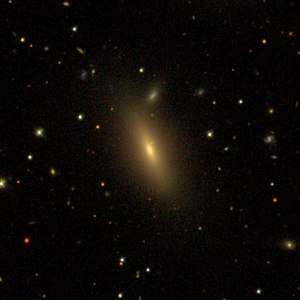NGC 517
NGC 517, also occasionally referred to as PGC 5214 or UGC 960, is a lenticular galaxy located approximately 188 million light-years from the Solar System[4] in the constellation Pisces.[2] It was discovered on 13 September 1784 by astronomer William Herschel.[5]
| NGC 517 | |
|---|---|
 | |
| Observation data (J2000[1] epoch) | |
| Constellation | Pisces[2] |
| Right ascension | 01h 24m 43.8s[3] |
| Declination | +33° 25′ 46″[3] |
| Redshift | 0.014003 ± 0.000193[1] |
| Helio radial velocity | (4169 ± 58) km/s[1] |
| Distance | 188 Mly[4] |
| Apparent magnitude (V) | 12.5[2] |
| Apparent magnitude (B) | 13.5[2] |
| Characteristics | |
| Type | S0[2] |
| Apparent size (V) | 1.4' × 0.5'[2] |
| Other designations | |
| PGC 5214, UGC 960, GC 301, MGC +05-04-054, 2MASS J01244381+3325465, h 114[1][5] | |
Observation history
Herschel discovered the object along with NGC 515 using Beta Andromedae as a reference star. He described his discovery as "two, both stellar", indicating his misidentification of the object as a star. While Herschel only noted one position about 35" east of NGC 515, Heinrich d'Arrest made the first accurate measurement of the object, using observation data of three separate nights.[6] The object was also observed by John Herschel, son of William Herschel and later catalogued by John Louis Emil Dreyer in the New General Catalogue, where the galaxy was described as "pretty faint, round, stellar, southeastern of 2" with the other one being NGC 517.[5]
Description
The galaxy has an apparent visual magnitude of 12.5 and can be classified as type S0 using the Hubble Sequence.[2] The object's distance of roughly 190 million light-years from the Solar System can be estimated using its redshift and Hubble's law.[4]
References
- "NGC 517". SIMBAD. Centre de données astronomiques de Strasbourg. Retrieved 2017-12-09.
- "Revised NGC Data for NGC 517". spider.seds.org. Retrieved 2017-10-05.
- "Your NED Search Results". ned.ipac.caltech.edu. Retrieved 2017-10-05.
- An object's distance from Earth can be determined using Hubble's law: v=Ho is Hubble's constant (70±5 (km/s)/Mpc). The relative uncertainty Δd/d divided by the distance is equal to the sum of the relative uncertainties of the velocity and v=Ho
- "New General Catalog Objects: NGC 500 - 549". cseligman.com. Retrieved 2017-10-16.
- "astronomy-mall.com/Adventures.In.Deep.Space/NGC%201-7840%20complete.htm".
External links
| Wikimedia Commons has media related to NGC 517. |
- NGC 517 on WikiSky: DSS2, SDSS, GALEX, IRAS, Hydrogen α, X-Ray, Astrophoto, Sky Map, Articles and images
- SEDS